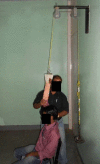Effectiveness of sustained stretching of the inferior capsule in the management of a frozen shoulder
- PMID: 24664198
- PMCID: PMC4048406
- DOI: 10.1007/s11999-014-3581-2
Effectiveness of sustained stretching of the inferior capsule in the management of a frozen shoulder
Abstract
Background: Physiotherapy treatment of frozen shoulder is varied, but most lack specific focus on the underlying disorder, which is the adhered shoulder capsule. Although positive effects were found after physiotherapy, the recurrence and prolonged disability of a frozen shoulder are major factors to focus on to provide the appropriate treatment.
Questions/purposes: We wished to study the effectiveness of a shoulder countertraction apparatus on ROM, pain, and function in patients with a frozen shoulder and compare their results with those of control subjects who received conventional physiotherapy.
Methods: A total of 100 participants were randomly assigned to an experimental group and a control group, with each group having 50 participants. The control group received physiotherapy and the experimental group received countertraction and physiotherapy. The total treatment time was 20 minutes a day for 5 days per week for 2 weeks. The outcome measures used were goniometer measurements, VAS, and the Oxford Shoulder Score.
Results: Improvements were seen in the scores for shoulder flexion (94.1° ± 19.79° at baseline increased to 161.9° ± 13.05° after intervention), abduction ROM (90.4° ± 21.18° at baseline increased to 154.8° ± 13.21° after intervention), and pain (8.00 ± 0.78 at baseline decreased to 3.48 ± 0.71 after intervention) in the experimental group. Sixty percent of the participants (n = 30) were improved to the fourth stage of satisfactory joint function according to the Oxford Shoulder Score in the experimental group compared with 18% (n = 9) in the control group (p < 0.001).
Conclusions: Incorporating shoulder countertraction along with physiotherapy improves shoulder function compared with physiotherapy alone for the treatment of a frozen shoulder. Additional studies are needed focusing on this concept to increase the generalizability of the counter-traction apparatus in various groups.
Level of evidence: Level II, prospective comparative study. See the Instructions for Authors for a complete description of levels of evidence.
Figures
Comment in
-
Reply to the letter to the editor: effectiveness of sustained stretching of the inferior capsule in the management of a frozen shoulder.Clin Orthop Relat Res. 2014 Dec;472(12):4041. doi: 10.1007/s11999-014-3950-x. Epub 2014 Sep 17. Clin Orthop Relat Res. 2014. PMID: 25227557 Free PMC article. No abstract available.
-
Letter to the editor: Effectiveness of sustained stretching of the inferior capsule in the management of a frozen shoulder.Clin Orthop Relat Res. 2014 Dec;472(12):4039-40. doi: 10.1007/s11999-014-3949-3. Epub 2014 Sep 19. Clin Orthop Relat Res. 2014. PMID: 25234287 Free PMC article. No abstract available.
References
Publication types
MeSH terms
LinkOut - more resources
Full Text Sources
Other Literature Sources
Medical
Research Materials



